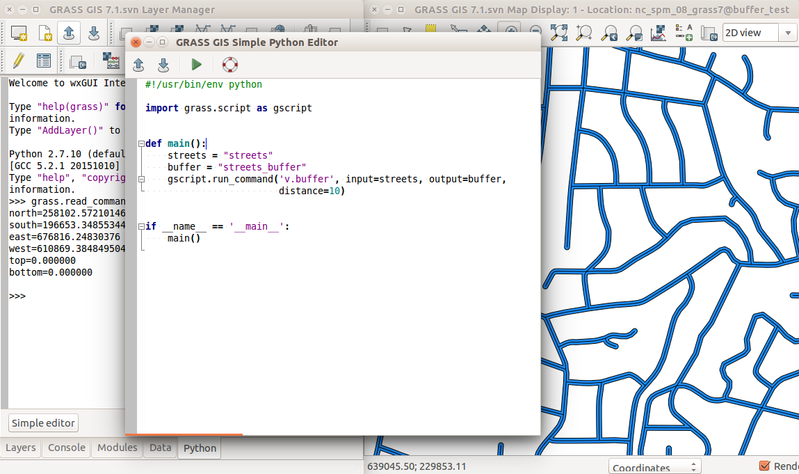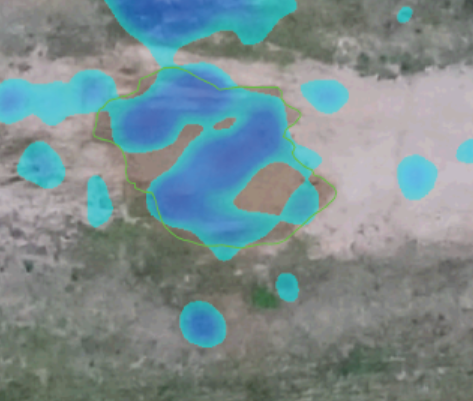FOSS4G NA 2016: GRASS related workshops and presentations
Jump to navigation
Jump to search



FOSS4G North America 2016, Raleigh, NC, USA, May 2-5, 2016, https://2016.foss4g-na.org/
List of sessions labeled GRASS GIS: https://2016.foss4g-na.org/session/grass-gis
There is also a Code Sprint and Unconference and GRASS GIS developers and users will be there.
Workshops
- Anna Petrasova, Vaclav Petras, Brendan Harmon, Helena Mitasova (2016): Using GRASS GIS through Python and tangible interfaces, FOSS4G North America 2016, Raleigh, NC, USA, May 2-5, 2016
- Description: Come and learn about scripting, graphical and tangible (!) interfaces for GRASS GIS, the powerful desktop GIS and geoprocessing backend. We will start with the Python interface and finish with Tangible Landscape, a new tangible interface for GRASS GIS. Python is the primary scripting language for GRASS GIS. We will demonstrate how to use Python to automate your geoprocessing workflows with GRASS GIS modules and develop custom algorithms using a Pythonic interface to access low level GRASS GIS library functions. We will also review several tips and tricks for parallelization. Tangible Landscape is an example of how the GRASS GIS Python API can be used to build new, cutting edge tools and advanced applications. Tangible Landscape is a collaborative 3D sketching tool which couples a 3D scanner, a projector and a physical 3D model with GRASS GIS. The workshop will be a truly hands-on experience – you will play with Tangible Landscape, using your hands to shape a sand model and drive geospatial processes. This workshop is open to beginners. There will be opportunities, however, to discuss more advanced topics tailored to individual interests in breakout sessions during the workshop. Participants should bring laptops with GRASS GIS 7 and their favorite Python editor. Beginners may consider using the latest OSGeo-Live virtual machine.
- Website: https://geospatial.ncsu.edu/osgeorel/tangible-landscape.html
- Workshop material: Using GRASS GIS through Python and tangible interfaces
Presentations


- Brendan Harmon, Anna Petrasova, Vaclav Petras (2016): Tangible interaction for GIS, Full talk in Other Cool Stuff track, FOSS4G North America 2016, Raleigh, NC, USA, May 2-5, 2016
- Description: Imagine being able to hold a GIS in your hands, feeling the shape of the earth, sculpting its topography, and directing the flow of water. We present Tangible Landscape, an open source tangible interface powered by GRASS GIS. Tangible Landscape physically, interactively manifests geospatial data so that you can naturally feel it, see it, and shape it. This makes GIS far more intuitive and accessible for beginners, empowers geospatial experts, and creates new exciting opportunities for developers - like gaming with GIS. In this talk we will introduce tangible interaction and why it matters for all things spatial, demonstrate a few applications such as disaster management and gaming, discuss how to digitally fabricate models, and show you how to implement and build your own system.
- Slides: http://baharmon.github.io/foss4g-na-2016/
- Website: https://geospatial.ncsu.edu/osgeorel/tangible-landscape.html
- Vaclav Petras, Anna Petrasova, Helena Mitasova (2016): GRASS GIS loves lidar, Full talk in Using FOSS4G track, FOSS4G North America 2016, Raleigh, NC, USA, May 2-5, 2016
- Description: Lidar and UAV measurements produce huge point clouds which cannot be handled by classic GIS tools. Not true! New GRASS GIS version offers several tools which are specifically designed for processing of lidar data and point clouds in general. Lidar devices and structure from motion (SfM) processing of UAV imagery are generating large and dense points clouds which are hard to handle as classic GIS vectors. Fortunately, GRASS GIS, a powerful desktop and backend GIS, has a selection of tools which can handle this kind of data. For example, various point cloud decimations are useful as a pre-processing step before interpolation. However, the most significant group of provided analyses uses 2D and 3D binning for highly efficient digital terrain model creation and also for various vegetation and surface analyses. Additionally, we will explore old and new ground classification techniques in GRASS GIS and which analyses PDAL has to offer in connection with GRASS GIS. In this talk we will also look at point clouds from small scanners, namely Kinect, and how these can be processed in GRASS GIS in combination with PCL to couple digital elevation models with scaled physical models. The tools available in GRASS GIS can be used through a graphical user interface or in Bash and Python scripts which can accommodate individual user workflows as well as specific developer needs. We will see how these relate and how to take advantage of all of them.
- Slides: http://wenzeslaus.github.io/grass-lidar-talks/
- Related modules: v.in.lidar, r.in.lidar, v.decimate, v.lidar.edgedetection, v.lidar.mcc, ...
- Justyna Jeziorska, Helena Mitasova, Anna Petrasova, Vaclav Petras, Brendan Harmon (2016): Open the classroom window for... DRONES!, Short talk in Education and Research track, FOSS4G North America 2016, Raleigh, NC, USA, May 2-5, 2016
- Description: Drones have recently moved from the battlefields to our backyards. Their use is exploding across the U.S. and the rest of the world. Engineers, photographers, journalists, surveyors, researchers and… Amazon, all speak with one voice: drones are here to stay. How does the open source software handle this attack? Can they win the battle with the proprietary solutions for geoprocessing the data from Unmanned Aerial Vehicles? We faced the problem designing innovative graduate level course “Spatiotemporal Analysis with UAV and LiDAR Data” at NC State. In this talk we will present our findings and the results of the processing combining proprietary and open source photogrammetric and GIS solutions. Turning photo imagery into very high resolution digital terrain models (couple cm/pix) gave us opportunity took the investigation various spatial phenomena on a new level. What challenges needed to be overcame for the open source to reach this level? We take our data to OpenDroneMap and Grass GIS, but why do we use proprietary software in some stages of the processing? Those are only some of the problems that we will tackle in this talk.
- William Hargrove (2016): Empirical Mining of Large Data Sets Helps to Solve Practical Large-Scale Forest Management and Monitoring Problems, Full talk in Big Data Day track, FOSS4G North America 2016, Raleigh, NC, USA, May 2-5, 2016
- Description: We present a panoply of examples where empirical mining and statistical analysis of large data sets have already proven useful to help handle vexing problems within the realm of large-scale forest ecology. Some prejudices may exist against empirical approaches, in favor of more process-oriented analytical methods. Because a full understanding and appreciation of particular ecological phenomena are possible only after process-driven, hypothesis-directed research, some forest ecologists may feel that purely empirical data harvesting may represent a less-than-satisfactory approach. Restricting ourselves exclusively to process-driven approaches, however, may result in substantially slower progress, and we may not be able to afford the delays caused by such specific approaches. Empirical methods allow trends, relationships and associations to emerge freely from the data themselves, unencumbered by preconceived theories, ideas and prejudices. Empirical methods can be extremely efficient at uncovering strong correlations with intermediate "linking" variables. Once identified, these correlative structures directly provide sufficient prognostic talent and predictive power to be harnessed by, e.g., Bayesian Belief Nets, which bias ecological management decisions made with incomplete information toward favorable outcomes. Empirical data-harvesting also generates a myriad of testable hypotheses regarding processes, some of which may even be correct. Quantitative statistical regionalizations using Multivariate Geographic Clustering have lended insights into carbon eddy-flux direction and magnitude, wildfire biophysical conditions, phenological ecoregions useful for vegetation type and monitoring, potential areas susceptible to sudden oak death, an invasive oak pathogen, global aquatic ecoregions and susceptibility to aquatic invasives, and forest vertical structure ecoregions, using extensive LiDAR data sets. Multivariate Spatio-Temporal Clustering, which quantitatively places alternative future conditions on a common footing with present conditions, allows prediction of present and future shifts in tree species ranges, given alternative climatic change forecasts. Unsupervised statistical multivariate clustering of smoothed phenology data every 8 days over a 14-year period produces a detailed set of annual maps of national vegetation types, including major disturbances. Examining the constancy of these phenological classifications at a particular location from year to year produces a national map showing the persistence of vegetation, regardless of vegetation type. Using temporal unmixing methods, national maps of evergreen and deciduous vegetation can be produced. A by-cell regression trend line can be used to analyze decadal trends in forest health nationally. Forest Decline maps are a composite of insect, disease, and anthropogenic factors causing chronic decreases in the satellite greenness of these forests, including hemlock wooly adelgid, aspen decline, mountain pine beetle, wildfire, tree harvest, and urbanization. Because the trend in phenological changes monitors vegetation responses, all disturbance and recovery events are detected and mapped through the behavior of the vegetation itself. As ecological changes occur with increasing rapidity, these empirical data-mining approaches may be the quickest means to find the most-actionable ecological policies and directions.
- Slides: http://www.geobabble.org/~hnw/first/Hargrove_IN52A-05/
Community sprint
We are meeting at the FOSS4G NA Code Sprint and Unconference on May 6 and May 7. See the dedicated Raleigh meetups page for details.